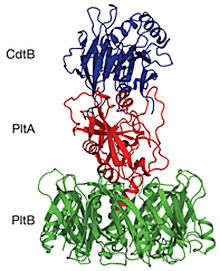Novel Structure and Function of Typhoid Toxin
Novel Structure and Function of Typhoid Toxin
Researchers gained important insights into the reasons why Salmonella typhi, the cause of typhoid fever, is so dangerous. The findings could help guide the development of therapeutics and improved vaccines against the infection.
More than 20 million people are infected with S. typhi each year, mainly in the developing world. Most cases in the United States occur in people who’ve traveled abroad to certain areas.

Structure of typhoid toxin, showing the 2 A subunits (blue and red) and 5 B subunits (green). /Image by the researchers, courtesy of Nature.
People become infected with the bacteria by consuming contaminated food or beverages. Once inside the body, the bacteria multiply and spread from the intestinal tract into the bloodstream. A few people, known as carriers, recover from typhoid fever but continue to carry the bacteria. Perhaps the most famous of these was Mary Mallon, also known as Typhoid Mary, who was the first documented typhoid carrier in the U.S.
Whereas other types of Salmonella bacteria cause salmonellosis or food poisoning, S. typhi is more toxic. Drs. Jeongmin Song, Xiang Gao and Jorge Galán of Yale University set out to determine the reason for the bacteria’s toxicity. Their research was funded by NIH’s National Institute of Allergy and Infectious Diseases (NIAID) and National Institute of General Medical Sciences (NIGMS). Results appeared on July 18, 2013, in Nature.
The researchers focused on typhoid toxin, a unique factor produced by S. typhi that was thought to contribute to the bacteria’s deadly effects. When they gave mice purified typhoid toxin, it caused symptoms similar to those in humans with typhoid fever, implicating typhoid toxin in the illness caused by S. typhi.
Typhoid toxin can bind to a wide variety of cells. Experiments revealed that the toxin attaches to certain types of proteins present on the surface of many cells. These proteins have specific carbohydrates called glycans attached to them that serve as beacons for the toxin. The researchers found that removing these surface glycans reduced typhoid toxin binding to cultured cells.
The scientists next determined the structure of the typhoid toxin. The toxin was already known to be an unusual type of “AB toxin.” Most AB toxins, such as pertussis toxin, are made from 1 type of A subunit and 1 type of B subunit (although the numbers of each can vary). Typhoid toxin, in contrast, has 2 types of A subunits (called PltA and CdtB) and 1 B subunit (PltB). PltA and PltB are similar to the subunits of pertussis toxin, while CdtB resembles toxins produced by several other bacteria. Together, these subunits create the unique, powerful typhoid toxin.
The researchers discovered that the typhoid toxin is actually made up of 1 molecule each of PltA and CdtB, along with 5 PltB molecules. This novel organization, known as A2B5, forms a pyramid-shaped complex. PltB has a pocket area that allows it to bind to surface glycans. When the team altered the structure of this pocket, the toxin could no longer bind to cultured cells or cause symptoms similar to typhoid fever in mice.
These findings provide a better understanding of the features of typhoid toxin and how it works to cause typhoid fever. While much more research will be needed, these findings could lead to new ways to treat and prevent typhoid fever.
“What makes this so exciting for us is that vaccines and therapeutics that target toxins have an excellent track record of success,” Galán says.
By Carol Torgan, Ph.D.
###
* The above story is reprinted from materials provided by National Institutes of Health (NIH)
** The National Institutes of Health (NIH) , a part of the U.S. Department of Health and Human Services, is the nation’s medical research agency—making important discoveries that improve health and save lives. The National Institutes of Health is made up of 27 different components called Institutes and Centers. Each has its own specific research agenda. All but three of these components receive their funding directly from Congress, and administrate their own budgets.



















